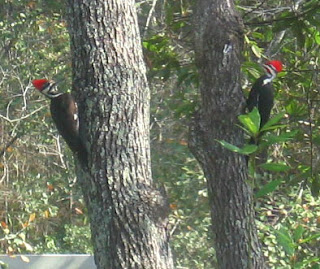Can the Birds Count on You???
 |
| Audubon's Call to its Christmas Bird Count |
Folks have been counting birds for decades, but can the birds count on you... to provide habitat filled with native plants that provide food, shelter, and places to raise their young?
This is the 111th year that Audubon Society has organized its Christmas bird count. This definitive data shows without a doubt that our native bird populations have decreased dramatically over the decades. Most of the declines are due to decreased habitat, but we are not helpless and we can all do much more than wring our hands in dismay.
 |
| Slide from Greg Braun's habitat presentation |
Greg Braun from Audubon of Martin County in south Florida created a slide show which illustrates specific examples of how and why people of south Florida can make a significant difference for their birds.
An important book that makes THE case for more native plants in the landscape for wildlife is Doug Tallamy's "Bringing Nature Home: How Native Plants Sustain Wildlife in Our Gardens." As our friend Ellen Honeycutt, an active member of the Georgia Native Plant Society, says, “People all over the country are reading this book and smacking their heads while thinking: ‘Of course, it all makes perfect sense now!’ “ You can purchase this book, which we have listed over in the right hand column along with our other favorites--just click the covers to link to Amazon. (When you purchase books here, FNPS receives a small referral fee.)
 |
| A little green heron in our front pond. Supplying water is part of habitat building. |
My personal experience in Florida habitat building goes back to 2004 when my husband and I moved to Florida and bought a house on a 1.5 acre lot with a good-sized natural pond in the front and a 110-acre lake out back. Much of the land had been cleared and sodded with St. Augustine and poisoned regularly by the previous owner. We stopped all poisoning right away and let some big patches of lawn go to meadow such as the area on the far side of the pond and on top of the septic tank drainfield mound where the grass was not doing well at all. Since then we have been reducing the rest of lawn area little by little and removing invasive plants.
Early in 2006, I applied for backyard habitat certification from the National Wildlife Federation and we are now habitat #59063. I hung the sign out front so the neighbors might be inclined to become certified as well. We are not in a restrictive HOA neighborhood and I know of several neighbors who have also certified their yards. I wrote about this process in Creating Backyard Habitat. Since then we have enjoyed a tremendous variety of bird visitors--it's always interesting.
 |
| Here this red shouldered hawk captured a mole from the front yard and was probably the one that took the wrens. |
 |
| A pair of pileated woodpeckers on our redbay trees, which are now gone, because of that dreadful fungus. See Red Bay Trees are Dying |
Our most recent bird adventure was seeing a woodcock! Last week as we were finishing dinner, I saw an animal rooting around in the backyard, but because it was getting dark I couldn't figure what it was--a squirrel without a tail? a bunny digging a hole?? It was not too far from the house, but with binoculars I could see that it was a bird, which I then identified as a woodcock! My husband had seen one earlier in the week down by the lake, but thought it was a shore bird. A new bird for both of us. Since then we've seen a single woodcock several times in the back yard and once we saw two woodcocks fly in at one time. I was prepared with a camera, but the light was too low for any type of photo with our point & shoot camera--even with a flash. They do a little wooble each time they stab their long bills into the lawn. Cute!
 |
| Woodcock--photo from Wiki-commons |
Audubon runs a Christmas bird count each year in December and January, so it's not too late to participate. See Audubon's bird count website for more information. The Green Blog on the NYTimes also posted an article about the importance of the annual bird count.
Ginny Stibolt




Comments
MERRY CHRISTMAS!
Hug!